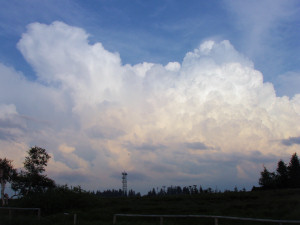Convective Orographically-induced Precipitation Study (COPS)

Introduction
The forecasting of convective precipitation in hilly terrain is important because of the devastating flooding that can be caused by the intense precipitation. A number of storms over the hills and low mountains have recently caused substantial flooding and other damage in the UK and other parts of Europe. The Hadley Centre regional model shows that one of the impacts of climate change is likely to be an increase in the frequency of extreme precipitation events. Convection plays an important part in many flood situations, especially flash floods. Unfortunately current forecast models are unable to accurately predict heavy convective showers and thunderstorms over orography. This is mainly because there is a poor understanding of thermally-driven orographic flow of moisture and aerosols which feed the storms and the details of the aerosols, microphysics and dynamics of the convective clouds, all of which control the production of precipitation in orographic convection. The Convective Orographically-induced Preceipitation Study (COPS) is an international project which was designed to address deficiencies in the understanding of these processes through an integrated programme of field measurements, data analysis and model simulation. This work will provide a greatly improved understanding of both the dynamical and microphysical processes controlling convective precipitation and so provide the basis for improving quantitative forecasts of convective precipitation.
Poor forecasts of convective precipitation are also a world-wide problem. COPS forms part of a series of experiments which have been carried out to investigate this problem, including IHOP 2002 (the US led project on convective initiation in the flat plains of the US), CSIP (a UK project, held in the low-hill region influenced by coasts in southern England) and COPS. In addition, importantly, the physics of many of the fundamental processes, such as surface fluxes, are common to all projects, but each project has focussed on different aspects since the projects have taken place in different climates. Therefore, the combined series of projects provided an opportunity to improve the understanding of severe convective storms and thus forecasting ability of heavy precipitation in the UK (and elsewhere) that would not have been possible without world-wide collaboration. In particular, the role of orography, aerosols and cloud microphysics in precipitation development and convective predictability could not be addressed using data from CSIP or IHOP. COPS provided a unqiue opporunity to understand the relative contributions of uncertatinties in fluxes, synpotic features and cloud microphysics to uncertainties in forecasts of convective precipitation.
Objectives
The core objective of the COPS project is understanding the precipitation produced in orographic convection and improving the ability to accurately forcast such precipitation. The project focusses on the most poorly understood aspects namely:
1. The prediction of deep convection over hilly terrain is extremely challenging because it depends critically on the mass, heat and water vapour fluxes associated with thermally driven flows which themselves depend critically on the highly detailed surface exchanges of heat and water.
2. The development of precipitating clouds is further complicated because it depends on the transport of aerosols by these thermal flows and on the highly nonlinear interaction between the cloud microphysics and the dynamics.
The problem involves five integrated parts that need to be tackled together.
Reducing uncertainty in predictability of the location and timing of convective storms in hilly terrain with the Unified Model (the standard model used by the Met Office and other organisations to produce operational forecasts), depends on the knowledge gained from these five parts. In particular the relative contributions of different sources of uncertainty in predictability of convective storms in hilly terrain will be quantified, thus providing the basis for an ensemble forecast system.